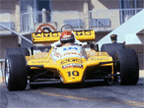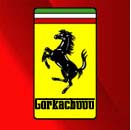EL TITULAR DEL DIA
Parece que don Max anda muy inquieto estos dias: ahora ha dicho que la regla del 107% en las clasificaciones podría entrar nuevamente en vigencia esta temporada.  De ser así creo que Super Aguri se podría ver afectado porque no creo que con ese viejo Arrows modificado puedan hacer buenos tiempos; habrá que esperar ...
De ser así creo que Super Aguri se podría ver afectado porque no creo que con ese viejo Arrows modificado puedan hacer buenos tiempos; habrá que esperar ...
Juanca


-

Juanca - Mensajes: 159
- Registrado: Mar Ene 18, 2005 2:13 pm
- Ubicación: Cali - Colombia
Juanca escribió:Parece que don Max anda muy inquieto estos dias: ahora ha dicho que la regla del 107% en las clasificaciones podría entrar nuevamente en vigencia esta temporada.De ser así creo que Super Aguri se podría ver afectado porque no creo que con ese viejo Arrows modificado puedan hacer buenos tiempos; habrá que esperar ...
Y es que nunca deberían haber quitado lo del 107%
Si un equipo no capaz de correr por debajo del 107% no merece disputar la carrera.
Saludos,
Schumi nº1

-

Schumi nº1 - Mensajes: 3902
- Registrado: Mar Mar 23, 2004 7:19 pm
- Ubicación: Barcelona
RE:
Aqui os dejo un artículo de Autosport al respecto. No es exactamente una regla del 110% para dejar fuera a los equipos que no lo consigan si no una medida para evitar tácticas de vueltas lentas para poder repostar antes de carrera.
Un saludo.
FIA moves to close qualifying loophole
By Jonathan Noble Friday, February 17th 2006, 17:23 GMT
Motor racing's governing body has moved to alleviate fears of drivers adopting bizarre 'go-slow' tactics in qualifying this year by introducing a 110 percent rule, autosport.com can reveal.
While the teams continue to ponder the implications of the new knock-out qualifying format, and try and pre-empt problems that may arise, the FIA has made it clear that it is only too willing to try and make the new system a success by agreeing to act on possible loopholes.
Sources have revealed that the most recent concern voiced by teams at a Technical Working Group meeting was of drivers deliberately going on an economy run to save fuel in the early stages of the final 20-minute session that decides the top 10 grid positions.
Teams are allowed to refuel their cars at the end of qualifying by an FIA-determined number of litres per lap they complete. Therefore, drivers can theoretically get a strategic advantage in the race if they burn off less fuel in qualifying than the FIA figure.
The go-slow tactics also opened up the possibility of dawdling drivers causing a danger on the track, as their speed could have caused problems for other drivers putting in quick laps in the early part of the session.
F1 teams are understood to have requested that some regulation be put in place to prevent these economy runs, and autosport.com understands that the FIA has now written to the teams explaining the solution.
The clarification means that, for the final 20-minute session, any driver who sets a lap that is more than 110 percent of his fastest qualifying lap will not have that lap count towards the tally of laps that they are allowed to refuel for after the session. It means that any drivers going slow will lose out on fuel, which could prove costly in the race.
A FIA spokesman told autosport.com: "The so-called 110% rule will ensure that drivers do not do very slow in or out laps in the third period of qualifying in an attempt to save fuel.
"If they are outside 110% of their own fastest lap that lap will not count towards their fuel credit."
The FIA originally introduced the fuel credit system in a bid to prevent teams from making expensive modifications to their engines to burn off maximum fuel in the early stages of the final session.
FIA president Max Mosley said earlier this week: "We will tell them, you have done eight laps, so you are allowed to put in 20 litres or whatever. Otherwise it would have been like having them going around with flamethrowers coming out of the back."
Un saludo.
Presumir de saber es el primer paso de la ignorancia.
 Multum in parvo. http://www.loschorreones.blogspot.com/
Multum in parvo. http://www.loschorreones.blogspot.com/
 Multum in parvo. http://www.loschorreones.blogspot.com/
Multum in parvo. http://www.loschorreones.blogspot.com/-

elnuevo - Mensajes: 3969
- Registrado: Jue Mar 11, 2004 7:20 pm
- Ubicación: 4 8 15 16 23 42
110%
If they are outside 110% of their own fastest lap that lap will not count towards their fuel credit 
Se refiere a comparar los tiempos de cada piloto con sus propios tiempos, si se pasa del 110 % en el tiempo de una vuelta esta no contará para su crédito de combustible.
Lo increible es que ahora tienen un credito de combustible a utilizar, relamente ya no hayan que inventar para hacer mas complicado este asunto de la calificación
Se refiere a comparar los tiempos de cada piloto con sus propios tiempos, si se pasa del 110 % en el tiempo de una vuelta esta no contará para su crédito de combustible.
Lo increible es que ahora tienen un credito de combustible a utilizar, relamente ya no hayan que inventar para hacer mas complicado este asunto de la calificación
-

Nicco - Mensajes: 98
- Registrado: Vie Jun 03, 2005 5:45 pm
- Ubicación: Poza Rica, Veracruz, mexico
¿Alguien me puede explicar eso del 'crédito de combustible'?
Para qué más complicado el nuevo formato de clasificación!!!
Saludos...
Para qué más complicado el nuevo formato de clasificación!!!
Saludos...

"Schumacher’s farewell drive in Brazil illustrated the grit, skill and determination that has made him the greatest driver Formula One racing has ever seen."
- Formula1.com
-

Schumi.cl - Mensajes: 1067
- Registrado: Mar Mar 09, 2004 8:57 pm
- Ubicación: Santiago, Chile
mmm
He leído el reglamento de 2006 más o menos en profundidad, concretamente el apartado de Refuelling y el de Qualifying Session, y no he encontrado estos créditos de combustible de los que habla Max Mosley. Creo que se refiere a...
Es decir, los 10 pilotos que participan en la última tanda pueden reemplazar si lo desan los litros que han consumido durante la tanda definitiva. Hasta aquí lo que dice el reglamento.
Max añade que la FIA decidirá cuántos litros por vuelta [L/vuelta] realizada en esta última manga se rellenará el depósito. Todos por igual, así habrá trato igualitario y se supondrá que todos consumen igual. El coche que consuma menos saldría beneficiado de esta norma.
La FIA ha pensado que si se rellenase el depósito a la cantidad inicial con la que cada piloto empezase la última tanda, los equipos podrían hacer que el motor consumiese muchísimo durante esas vueltas de calificación [bajarían en pocas vueltas el peso de la gasolina pudiendo hacer buenos cronos]. Tendrían ventaja sobre los que no lo hicieran porque pondrían el motor en modo "Consumo Normal" al empezar la carrera, teniendo la cantidad inicial de combustible de la calificación, que se supone que sería mucha.
Imagino que esto es el crédito de combustible. Rellenar el depósito de los pilotos que corren la última tanda con una cantidad por vuelta fija para evitar que haya trampas.
Un saludo.
88] b) Fuel may not be added to nor removed from any car eligible to take part in the third period of qualifying practice during that period. At any time between the end of qualifying and one hour and thirty minutes before the start of the formation lap fuel used during the third period of qualifying may be replaced.
Es decir, los 10 pilotos que participan en la última tanda pueden reemplazar si lo desan los litros que han consumido durante la tanda definitiva. Hasta aquí lo que dice el reglamento.
Max añade que la FIA decidirá cuántos litros por vuelta [L/vuelta] realizada en esta última manga se rellenará el depósito. Todos por igual, así habrá trato igualitario y se supondrá que todos consumen igual. El coche que consuma menos saldría beneficiado de esta norma.
La FIA ha pensado que si se rellenase el depósito a la cantidad inicial con la que cada piloto empezase la última tanda, los equipos podrían hacer que el motor consumiese muchísimo durante esas vueltas de calificación [bajarían en pocas vueltas el peso de la gasolina pudiendo hacer buenos cronos]. Tendrían ventaja sobre los que no lo hicieran porque pondrían el motor en modo "Consumo Normal" al empezar la carrera, teniendo la cantidad inicial de combustible de la calificación, que se supone que sería mucha.
Imagino que esto es el crédito de combustible. Rellenar el depósito de los pilotos que corren la última tanda con una cantidad por vuelta fija para evitar que haya trampas.
Un saludo.
-

Ponton17 - Mensajes: 398
- Registrado: Sab Mar 08, 2003 1:35 am
- Ubicación: Barcelona
mmm
Parece ser que los créditos de combustible eran una simple propuesta de Max Mosley, porque no se ha vuelto a oír nada más sobre ella y el reglamento no se ha actualizado.
Ahora mismo, el método para rellenar el depóstio de combustible para los 10 pilotos que participen en la última sesión de la Calificación será el típico: medir el combustible con el que inician la tanda y al finalizar ésta, se les volverá a elevar el nivel de gasolina al estado inicial.
Si algún equipo se las ingenia para aumentar considerablemente el consumo de carburante durante esos 20 minutos, podría iniciar la sesión bien lleno y vaciarlo enseguida para poder marcar buenos tiempos ya estando ligero. Espero que no se vaya derramando gasolina pora ahí, qué triste sería. A ver si Honda se nos aparece de nuevo con un segundo depósito oculto...
Un saludo.
Ahora mismo, el método para rellenar el depóstio de combustible para los 10 pilotos que participen en la última sesión de la Calificación será el típico: medir el combustible con el que inician la tanda y al finalizar ésta, se les volverá a elevar el nivel de gasolina al estado inicial.
Si algún equipo se las ingenia para aumentar considerablemente el consumo de carburante durante esos 20 minutos, podría iniciar la sesión bien lleno y vaciarlo enseguida para poder marcar buenos tiempos ya estando ligero. Espero que no se vaya derramando gasolina pora ahí, qué triste sería. A ver si Honda se nos aparece de nuevo con un segundo depósito oculto...

Un saludo.
-

Ponton17 - Mensajes: 398
- Registrado: Sab Mar 08, 2003 1:35 am
- Ubicación: Barcelona
Finalmente todos los equipos han aprobado la restricción de los días de prueba para bajar los costes. Los días de prueba se han limitado a 36. Eso sí, cada equipo puede elegir un 'circuito de casa' en el que cada día que pruebe se contará como medio día en el total de 36. El circuito de Barcelona no se podrá elegir por ningún equipo por ser el más popular en este apartado.
Además, existirá un límite de kilometraje en cada prueba para que ningún equipo se aproveche de probar con 3 autos o más y por consiguiente suban los costes en general.
Por otro lado, las pruebas en línea recta para trabajar la aerodinámica (como hace Ferrari en Vairano) no se incluirán en este límite de 36 días, sino que tendrán 12 días especialmente dados para ese tipo de prueba.
Saludos...
Además, existirá un límite de kilometraje en cada prueba para que ningún equipo se aproveche de probar con 3 autos o más y por consiguiente suban los costes en general.
Por otro lado, las pruebas en línea recta para trabajar la aerodinámica (como hace Ferrari en Vairano) no se incluirán en este límite de 36 días, sino que tendrán 12 días especialmente dados para ese tipo de prueba.
Saludos...

"Schumacher’s farewell drive in Brazil illustrated the grit, skill and determination that has made him the greatest driver Formula One racing has ever seen."
- Formula1.com
-

Schumi.cl - Mensajes: 1067
- Registrado: Mar Mar 09, 2004 8:57 pm
- Ubicación: Santiago, Chile
Polemica servida.
El año pasado fue Renault y este año le ha tocado a Ferrari. Primera carrera y suspicacias entre los demás equipos por la supuesta utilización de un alerón trasero ilegal. La FIA, en boca de Charlie Whitin y Jo Bauer, insiste en que no hay problema. Polémica servida y acabamos de empezar.

Un saludo.

Un saludo.
Presumir de saber es el primer paso de la ignorancia.
 Multum in parvo. http://www.loschorreones.blogspot.com/
Multum in parvo. http://www.loschorreones.blogspot.com/
 Multum in parvo. http://www.loschorreones.blogspot.com/
Multum in parvo. http://www.loschorreones.blogspot.com/-

elnuevo - Mensajes: 3969
- Registrado: Jue Mar 11, 2004 7:20 pm
- Ubicación: 4 8 15 16 23 42
titot escribió:Supongo que ya es pedir mucho, pero porque dicen los demas equipos que el aleron es ilegal?
Porque según dicen, el alerón es flexible, es decir, la misma situación que atravesó Renault el año pasado.

-

Gorkachuuu - Mensajes: 625
- Registrado: Mié Ago 17, 2005 12:12 pm
Segun lo que entendi en F1total  es que la FIA introdujo hace varios años los ensayos de carga que son completados de la siguiente manera: En los bordes de las alas se aseguran pesas preestablecidas, si el ala se pliega muy fuertemente se da por ilegal. En Ferrari han encontrado sinembargo un hueco del reglamento y e insertaron la flexibilidad en un lugar que no es probado por el test de la FIA. Por lo tanto son legales. Igual los demas equipos no estan de acuerdo con esta decision y Pat Symmonds de Renault asegura que es obvio que se pueden obtener ventajas con esa disposicion.
es que la FIA introdujo hace varios años los ensayos de carga que son completados de la siguiente manera: En los bordes de las alas se aseguran pesas preestablecidas, si el ala se pliega muy fuertemente se da por ilegal. En Ferrari han encontrado sinembargo un hueco del reglamento y e insertaron la flexibilidad en un lugar que no es probado por el test de la FIA. Por lo tanto son legales. Igual los demas equipos no estan de acuerdo con esta decision y Pat Symmonds de Renault asegura que es obvio que se pueden obtener ventajas con esa disposicion.
Salut!!
Salut!!

"La imaginacion es mas importante que el conocimiento". Albert E.
-

Piloto 0 - Mensajes: 276
- Registrado: Vie Mar 07, 2003 1:00 am
- Ubicación: Bogota.... ¬¬
Re: mmm
Ponton17 escribió:He leído el reglamento de 2006 más o menos en profundidad, concretamente el apartado de Refuelling y el de Qualifying Session, y no he encontrado estos créditos de combustible de los que habla Max Mosley. Creo que se refiere a...88] b) Fuel may not be added to nor removed from any car eligible to take part in the third period of qualifying practice during that period. At any time between the end of qualifying and one hour and thirty minutes before the start of the formation lap fuel used during the third period of qualifying may be replaced.
Es decir, los 10 pilotos que participan en la última tanda pueden reemplazar si lo desan los litros que han consumido durante la tanda definitiva. Hasta aquí lo que dice el reglamento.
Max añade que la FIA decidirá cuántos litros por vuelta [L/vuelta] realizada en esta última manga se rellenará el depósito. Todos por igual, así habrá trato igualitario y se supondrá que todos consumen igual. El coche que consuma menos saldría beneficiado de esta norma.
La FIA ha pensado que si se rellenase el depósito a la cantidad inicial con la que cada piloto empezase la última tanda, los equipos podrían hacer que el motor consumiese muchísimo durante esas vueltas de calificación [bajarían en pocas vueltas el peso de la gasolina pudiendo hacer buenos cronos]. Tendrían ventaja sobre los que no lo hicieran porque pondrían el motor en modo "Consumo Normal" al empezar la carrera, teniendo la cantidad inicial de combustible de la calificación, que se supone que sería mucha.
Imagino que esto es el crédito de combustible. Rellenar el depósito de los pilotos que corren la última tanda con una cantidad por vuelta fija para evitar que haya trampas.
Un saludo.
He oído 2'7kilos de combustible por vuelta en la Q3
Una pregunta, os parece que sigue teniendo tanta importancia como el año pasado salir cargado de combustible ? Se verán équipos con tres repostajes por GP más a menudo este año?
Saludos!
- slick
- Mensajes: 33
- Registrado: Mar Mar 29, 2005 8:49 pm
Re: mmm
slick escribió:Una pregunta, os parece que sigue teniendo tanta importancia como el año pasado salir cargado de combustible ? Se verán équipos con tres repostajes por GP más a menudo este año?
Saludos!
Es una pregunta complicada, deberemos ver lo que hacen los equipos a medida que se sucedan los Grandes Premios. Yo más bien creo que la tendencia será a ir a dos repostajes para los hombres de delante y tal vez algún equipo de mitad de parrilla trate de arriesgar con 3 paradas. Viendo el caso concreto de Kimi en Bahrein, con su única y súper efectiva parada a boxes, puede que sea la mejor opción para los coches que traten bien los neumáticos como es el caso de McLaren. Mi resúmen sería que 2 será el estándard para la mayoría, McLaren podría jugar la estrategia de una, y de vez en cuando se verán 3 paradas en algún equipo que quiera arriesgar.
Por otro lado, he leído una noticia sobre la posibilidad de que Pedro corra en Renault para 2007. Honestamente, creo 1% en que eso suceda, pero para mí es el titular del día:
http://www.marca.com/edicion/marca/moto ... 28261.html
Tilke y De la Rosa, sin más

Saludos.
-

Ponton17 - Mensajes: 398
- Registrado: Sab Mar 08, 2003 1:35 am
- Ubicación: Barcelona
Sin duda el titular del día es que el GP de Japón 2007 se realizará en el circuito de Fuji (creo que no se ha comentado aún en el foro):
Fuji albergará GP de Japón 2007
El circuito japonés de Fuji organizará el Gran Premio de Japón en el año 2007, según han publicado varios medios de comunicación. Al parecer, Bernie Ecclestone ha dicho a la prensa japonesa que FOA ha firmado un contrato, que entrará en vigor la próxima temporada, con Fuji-Speedway.
Suzuka, circuito en que se tendrá lugar este año el GP de Japón, ha albergado de Fórmula Uno desde 1987. El presidente de la pista japonesa, Ikuo Shimizu se reunió con Ecclestone la semana pasada en Bahrein para intentar convencerle de que la carrera continuase disputándose en sus instalaciones.
En declaraciones a 'The Yomiuri Shimbun' el japonés insistió en que "no me sorprende que Fuji organice una carrera de F1. No obstante, continuaremos negociando para llegar a un acuerdo con Ecclestone".
Ecclestone ya ha dicho que sería interesante ver dos carreras de la máxima categoría del autmovilismo en Japón, ahora que hay tres equipos de dicho país compitiendo en el campeonato mundial.
Fuente: F1Racing
Saludos...
Fuji albergará GP de Japón 2007
El circuito japonés de Fuji organizará el Gran Premio de Japón en el año 2007, según han publicado varios medios de comunicación. Al parecer, Bernie Ecclestone ha dicho a la prensa japonesa que FOA ha firmado un contrato, que entrará en vigor la próxima temporada, con Fuji-Speedway.
Suzuka, circuito en que se tendrá lugar este año el GP de Japón, ha albergado de Fórmula Uno desde 1987. El presidente de la pista japonesa, Ikuo Shimizu se reunió con Ecclestone la semana pasada en Bahrein para intentar convencerle de que la carrera continuase disputándose en sus instalaciones.
En declaraciones a 'The Yomiuri Shimbun' el japonés insistió en que "no me sorprende que Fuji organice una carrera de F1. No obstante, continuaremos negociando para llegar a un acuerdo con Ecclestone".
Ecclestone ya ha dicho que sería interesante ver dos carreras de la máxima categoría del autmovilismo en Japón, ahora que hay tres equipos de dicho país compitiendo en el campeonato mundial.
Fuente: F1Racing
Saludos...

"Schumacher’s farewell drive in Brazil illustrated the grit, skill and determination that has made him the greatest driver Formula One racing has ever seen."
- Formula1.com
-

Schumi.cl - Mensajes: 1067
- Registrado: Mar Mar 09, 2004 8:57 pm
- Ubicación: Santiago, Chile
Bueno, ahora parece que el R26 está bajo la lupa de la FIA:
De F1-Live:
De F1-Live:
LA FIA PODRIA INSPECCIONAR EL ALERON TRASERO DEL R26
y solicitar cambios también en el Ferrari
Paradójicamente, después de que Renault cuestionara la legalidad del alerón trasero de Ferrari, ahora existen rumores de que el equipo francés podría ser objeto de una inspección de la FIA en Malasia para comprobar una serie de cosas en su R26.
El delegado de la FIA, Charlie Whiting, podría haber solicitado una reunión con el Director de Ingeniería de Renault, Pat Symonds, para examinar las aletas que van fijadas al alerón trasero del R26 y que al parecer podrían doblarse a alta velocidad, reduciendo así la fricción del viento.
Según la publicación alemana Auto Motor Und Sport, el alerón posterior del Renault R26 está diseñado de forma que cuando se rueda a alta velocidad esos elementos del alerón escapen a la fricción del viento.
Uno de los temas importantes en el caso de la flexibilidad del alerón del Ferrari, es que a diferencia de cualquier otro equipo, el alerón posterior del 248 F1 no va reforzado con apoyos verticales, lo que en teoría podría permitir al alerón doblarse a alta velocidad.
Según Auto Motor Und Sport, la FIA podría solicitarle a Ferrari que instalara esos soportes verticales.
L.S. / Fuente GMM
CAPSIS International
Juanca


-

Juanca - Mensajes: 159
- Registrado: Mar Ene 18, 2005 2:13 pm
- Ubicación: Cali - Colombia
Reglamento 2008.
La FIA publicará mañana las nuevas regulaciones previstas para 2008, que Dios nos pille confesados. 
Tengo más miedo a eso que a un certificado de Hacienda.


Tengo más miedo a eso que a un certificado de Hacienda.

- riquii
- Mensajes: 6498
- Registrado: Mar Mar 02, 2004 2:23 pm
- Ubicación: f1vips.foroactivo.com
Re: Reglamento 2008.
riquii escribió:La FIA publicará mañana las nuevas regulaciones previstas para 2008, que Dios nos pille confesados.
Tengo más miedo a eso que a un certificado de Hacienda.
Lo que leí por ahi:
- El desarrollo de motores se congela por 3 años.
- Se permitirán maximo 20 carreras por temporada.
- Se permitirán máximo 12 equipos por temporada.
- La penalización de 10 puestos en la grilla por cambio de motor se reemplaza por un incremento de 15 Kg. de peso en los autos.
- Se elimina el requisito del depósito de US$48 millones para la entrada de nuevos equipos a la categoría. A partir del 2008 tendrían que hacer un pago de 300.000 euros.
A mi parecer el tema de congelar el desarrollo de los motores me parece absurdo, obviamente es una forma de reducir costos, pero sacrificando la evolución tecnológica no creo que sea la mejor manera de hacerlo.
------------
Edito para adicionar otros cambios que se supone fueron ya aprobados ayer, y al igual que los anteriores aplicarían del 2008 hasta el 2010:
- Las cajas de cambios deberán durar 4 carreras.
- Habrá un sólo proveedor de neumáticos
- Los tests se limitarán a 30.000 Kms por año.
- Las condiciones de "parque cerrado" iniciarían desde las 6:30 p.m. del viernes previo a la carrera (actualmente inician despues de la clasificación).
Toca esperar el comunicado oficial de la FIA para conocer más detalles.
Juanca


-

Juanca - Mensajes: 159
- Registrado: Mar Ene 18, 2005 2:13 pm
- Ubicación: Cali - Colombia
¿Quién está conectado?
Usuarios navegando por este Foro: No hay usuarios registrados visitando el Foro y 148 invitados


